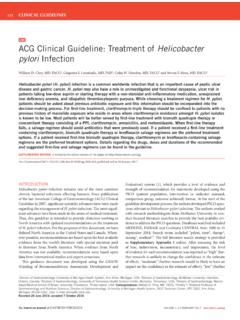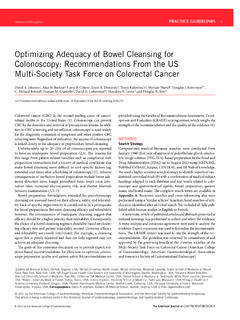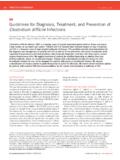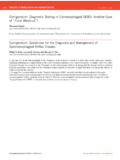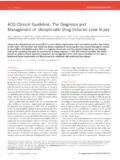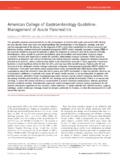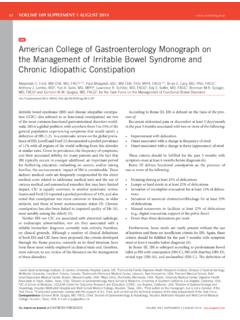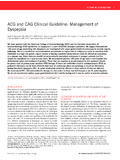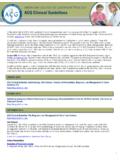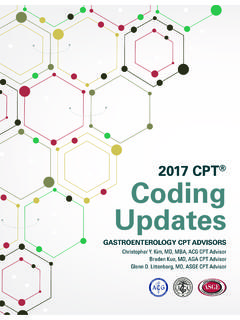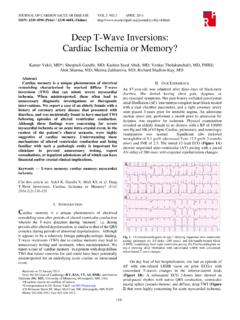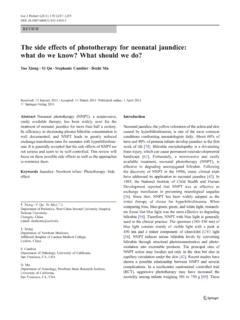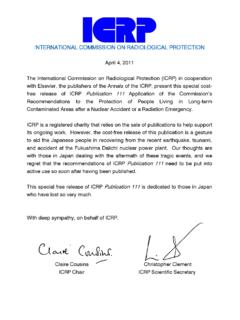Transcription of ACG Clinical Guideline: Evaluation of Abnormal …
1 18 The American journal of GASTROENTEROLOGY VOLUME 112 | JANUARY 2017 guidelines INTRODUCTION Th e authors were invited by the Board of Trustees and Practice guidelines Committee of the American College of Gastroenterol-ogy to develop a practice guideline regarding the Evaluation of Abnormal liver chemistries. We used the following resources: 1 . A formal review and literature search of the world literature on MEDLINE and EMBASE databases dealing with the Evaluation of Abnormal liver chemistries, studies that dealt with normal or reference range for alanine aminotransferase (ALT) levels and what thresholds trigger an Evaluation for actionable liver disease. Studies detailing the relationship between ALT and nonalcoholic fatty liver disease, as well as studies assessing the signifi cance of elevated liver chemistries on overall mortality and morbidity.
2 2 . Guideline policies of the American College of Gastroenterology. 3 . Th e experience of the authors and independent reviewers, as well as communication with senior hepatologists across the United States with regard to the threshold for evaluating Abnormal liver chemistries. Th ese recommendations are intended for use by physicians and health care providers and suggest preferred approaches to the diag-noses and Evaluation of those with Abnormal liver tests ( Ta b l e 1 ) . Th ese guidelines are intended to be fl exible and should be adjusted as deemed appropriate when applied to individual patients. Recommendations are evidence-based where possible. On subjects lacking rigid scientifi c data, recommendations are made based on the consensus opinion of the authors. To more fully characterize the available evidence reporting the recommendations, the ACG ACG Clinical Guideline: Evaluation of Abnormal Liver Chemistries P a u l Y.
3 K w o , M D , F A C G , F A A S L D 1 , Stanley M. Cohen , MD, FACG, FAASLD 2 and Joseph K. Lim , MD, FACG, FAASLD 3 Clinicians are required to assess Abnormal liver chemistries on a daily basis. The most common liver chemistries ordered are serum alanine aminotransferase (ALT), aspartate aminotransferase (AST), alkaline phosphatase and bilirubin. These tests should be termed liver chemistries or liver tests. Hepatocellular injury is defi ned as disproportionate elevation of AST and ALT levels compared with alkaline phosphatase levels. Cholestatic injury is defi ned as disproportionate elevation of alkaline phosphatase level as compared with AST and ALT levels. The majority of bilirubin circulates as unconjugated bilirubin and an elevated conjugated bilirubin implies hepatocellular disease or cholestasis.
4 Multiple studies have demonstrated that the presence of an elevated ALT has been associated with increased liver-related mortality. A true healthy normal ALT level ranges from 29 to 33 IU/l for males, 19 to 25 IU/l for females and levels above this should be assessed. The degree of elevation of ALT and or AST in the Clinical setting helps guide the Evaluation . The Evaluation of hepatocellular injury includes testing for viral hepatitis A, B, and C, assessment for nonalcoholic fatty liver disease and alcoholic liver disease, screening for hereditary hemochromatosis, autoimmune hepatitis, Wilson s disease, and alpha-1 antitrypsin defi ciency. In addition, a history of prescribed and over-the-counter medicines should be sought. For the Evaluation of an alkaline phosphatase elevation determined to be of hepatic origin, testing for primary biliary cholangitis and primary sclerosing cholangitis should be undertaken.
5 Total bilirubin elevation can occur in either cholestatic or hepatocellular diseases. Elevated total serum bilirubin levels should be fractionated to direct and indirect bilirubin fractions and an elevated serum conjugated bilirubin implies hepatocellular disease or biliary obstruction in most settings. A liver biopsy may be considered when serologic testing and imaging fails to elucidate a diagnosis, to stage a condition, or when multiple diagnoses are possible. Am J Gastroenterol 2017; 112:18 35; doi: ; published online 20 December 2016 1 Division of Gastroenterology/Hepatology, Department of Medicine, Stanford University School of Medicine , Palo Alto , California , USA ; 2 Digestive Health Institute, University Hospitals Cleveland Medical Center and Division of Gastroenterology and Liver Disease, Department of Medicine, Case Western Reserve University School of Medicine , Cleveland , Ohio , USA ; 3 Yale Viral Hepatitis Program, Yale University School of Medicine , New Haven , Connecticut , USA.
6 Correspondence: Paul Y. Kwo, MD, FACG, FAASLD, Division of Gastroenterology/Hepatology, Stanford University School of Medicine , 750 Welch Road, Suite 210 , Palo Alto , California 94304 , USA . E-mail: Received 11 February 2016 ; accepted 15 September 2016 CMEE valuation of Abnormal Liver Tests 2017 by the American College of Gastroenterology The American journal of GASTROENTEROLOGY 19 Practice Guideline Committee has adopted the classifi cation used by the grading of recommendation assessment, development, and Evaluation workup with modifi cations. Th e strength of recommen-dations are classifi ed as strong or conditional. Th e quality of evi-dence supporting strong or weak recommendations are designated by the following level is high, moderate low, or very low quality ( 1 ). Th is is a practice guideline rather than a review article.
7 Liver chemistries that are commonly ordered in comprehensive metabolic profi les are indirect markers of hepatobiliary disease. Th ey are not true measures of hepatic function and thus are best referred Table 1 . Recommendations 1. Before initiation of Evaluation of Abnormal liver chemistries, one should repeat the lab panel and/or perform a clarifying test ( , GGT if serum alkaline phosphate is elevated) to confi rm that the liver chemistry is actually Abnormal . (Strong recommendation, very low level of evidence). 2. Testing for chronic hepatitis C is conducted with anti-HCV and confi rmation is performed with HCV-RNA by nucleic acid testing. Risk factors for hepatitis C include history of intranasal or intravenous drug use, tattoos, body piercings, blood transfusions, high risk sexual conduct, and those born between 1945 and 1965. Testing for acute hepatitis C is with anti-HCV and HCV RNA by nucleic acid testing.
8 (Strong recommendation, very low level of evidence). 3. Testing for chronic hepatitis B is conducted with HBsAg testing. Testing for acute hepatitis B is with HBsAg and IgM anti-HBc. The following groups are at highest risk: persons born in endemic or hyperendemic areas (HBsAg prevalence >2%), men who have sex with men, persons who have ever used injection drugs, dialysis patients, HIV-infected individuals, pregnant women, and family members, household members, and sexual contacts of HBV-infected persons. (Strong recommendation, very low level of evidence). 4. Testing for acute Hepatitis A (IgM HAV) should occur in patients presenting with acute hepatitis and possible fecal-oral exposure. Testing for acute hepatitis E (IgM HEV) should also be considered in those returning from endemic areas and whose tests for acute hepatitis A, B, and C are negative. (Strong recom-mendation, very low level of evidence).
9 5. Patients with elevated BMI and other features of metabolic syndrome including diabetes mellitus, overweight or obesity, hyperlipidemia, or hypertension with mild elevations of ALT should undergo screening for NAFLD with ultrasound. (Strong recommendation, very low level of evidence). 6. Women consuming more than 140 g per week or men consuming more than 210 g per week who present with AST>ALT should be considered at risk for alcoholic liver disease and should be counseled for alcohol cessation. (Strong recommendation, very low level of evidence). 7. All patients with Abnormal liver chemistries in the absence of acute hepatitis should undergo testing for hereditary hemochromatosis with an iron level, transferrin saturation, and serum ferritin. HFE gene mutation analysis should be performed in patients with transferrin saturation 45% and/or elevated serum ferritin.
10 (Strong recommendation, very low level of evidence). 8. Patients with Abnormal AST and ALT levels, particularly patients with other autoimmune conditions, should undergo testing for autoimmune liver disease including ANA, ASMA, and globulin level. (Strong recommendation, very low level of evidence). 9. Patients with persistently elevated AST and ALT levels, especially patients <55 years of age, should undergo screening for Wilson s disease with serum ceruloplasmin testing. In the setting of low ceruloplasmin, confi rmatory testing with 24-h urinary copper and slit-lamp eye examination to identify pathogno-monic Kayser Fleischer rings should occur. (Strong recommendation, very low level of evidence). 10. Patients with persistently elevated AST or ALT should undergo screening for alpha-1 anti-trypsin (A1AT) defi ciency with alpha-1 anti-trypsin phenotype.
